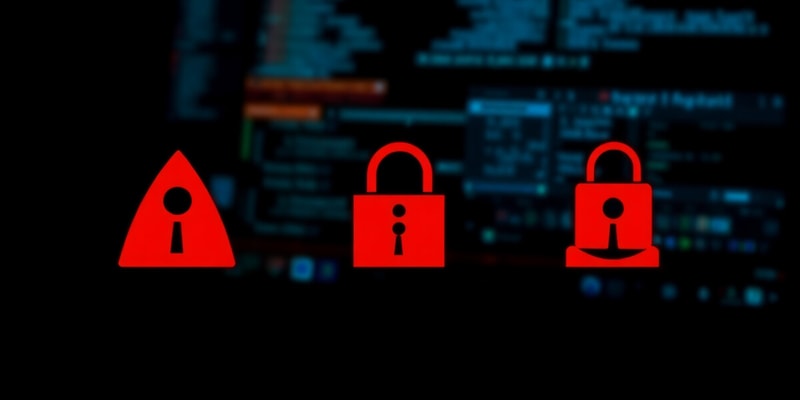Podcast
Questions and Answers
ซอฟต์แวร์ประเภทใดที่มักจะแพร่กระจายไปยังระบบเครือข่ายโดยไม่ต้องมีการแทรกแซงจากผู้ใช้?
ซอฟต์แวร์ประเภทใดที่มักจะแพร่กระจายไปยังระบบเครือข่ายโดยไม่ต้องมีการแทรกแซงจากผู้ใช้?
วิธีการแพร่เชื้อของมัลแวร์แบบใดที่ใช้การหลอกลวงผ่านอีเมลหรือข้อความ?
วิธีการแพร่เชื้อของมัลแวร์แบบใดที่ใช้การหลอกลวงผ่านอีเมลหรือข้อความ?
ซอฟต์แวร์ประเภทใดที่มีจุดประสงค์หลักเพื่อแอบติดตามและรวบรวมข้อมูลของผู้ใช้?
ซอฟต์แวร์ประเภทใดที่มีจุดประสงค์หลักเพื่อแอบติดตามและรวบรวมข้อมูลของผู้ใช้?
อะไรสามารถเป็นผลกระทบจากการโจมตีของมัลแวร์ที่สามารถส่งผลต่อชื่อเสียงและความเชื่อถือได้?
อะไรสามารถเป็นผลกระทบจากการโจมตีของมัลแวร์ที่สามารถส่งผลต่อชื่อเสียงและความเชื่อถือได้?
Signup and view all the answers
มัลแวร์ประเภทใดที่ทำให้ผู้ใช้ต้องจ่ายค่าไถ่เพื่อเข้าถึงข้อมูลที่ถูกล็อก?
มัลแวร์ประเภทใดที่ทำให้ผู้ใช้ต้องจ่ายค่าไถ่เพื่อเข้าถึงข้อมูลที่ถูกล็อก?
Signup and view all the answers
โปรแกรมที่สามารถควบคุมอุปกรณ์คอมพิวเตอร์โดยไม่ถูกตรวจพบเรียกว่าอะไร?
โปรแกรมที่สามารถควบคุมอุปกรณ์คอมพิวเตอร์โดยไม่ถูกตรวจพบเรียกว่าอะไร?
Signup and view all the answers
อะไรเป็นวิธีที่ดีที่สุดในการป้องกันการโจมตีจากมัลแวร์?
อะไรเป็นวิธีที่ดีที่สุดในการป้องกันการโจมตีจากมัลแวร์?
Signup and view all the answers
โปรแกรมที่ออกแบบมาเพื่อทำงานอัตโนมัติออนไลน์ซึ่งมักใช้ในเครือข่ายบอทคืออะไร?
โปรแกรมที่ออกแบบมาเพื่อทำงานอัตโนมัติออนไลน์ซึ่งมักใช้ในเครือข่ายบอทคืออะไร?
Signup and view all the answers
ประเภทของมัลแวร์ที่แสดงโฆษณาที่ไม่ต้องการและอาจนำไปสู่สปายแวร์คืออะไร?
ประเภทของมัลแวร์ที่แสดงโฆษณาที่ไม่ต้องการและอาจนำไปสู่สปายแวร์คืออะไร?
Signup and view all the answers
Study Notes
Definition
- Malware (malicious software) refers to any software designed to harm, exploit, or otherwise compromise computer systems, networks, or devices.
Types of Malware
-
Viruses:
- Attach to legitimate files and spread when infected files are shared.
-
Worms:
- Self-replicating malware that spreads across networks without user intervention.
-
Trojan Horses:
- Disguised as legitimate software to trick users into installing them; does not replicate.
-
Ransomware:
- Encrypts files or locks users out, demanding a ransom for access restoration.
-
Spyware:
- Secretly monitors user activity, collecting information for malicious purposes.
-
Adware:
- Displays unwanted advertisements, sometimes bundled with legitimate software; can lead to spyware.
-
Rootkits:
- Tools that allow unauthorized access and control of a computer without detection.
-
Bots:
- Automated programs that can perform tasks online, often used in botnets for malicious purposes.
Infection Methods
- Phishing: Fraudulent emails or messages that trick users into downloading malware.
- Malicious websites: Sites designed to distribute malware or host exploit kits.
- Drive-by downloads: Automatic download of malware when visiting a compromised site.
- Removable media: USB drives or other devices containing malware that infect the host system upon connection.
Consequences
- Data loss or theft
- Unauthorized access to systems
- Financial loss due to ransom or fraud
- Damage to reputation and trust
- Disruption of operations
Prevention Measures
- Antivirus Software: Regularly updated software to detect and remove malware.
- Firewalls: Network security systems that monitor and control incoming and outgoing traffic.
- Regular updates: Keeping software and systems updated to patch vulnerabilities.
- User education: Training users to recognize phishing attempts and other social engineering tactics.
- Backup data: Regularly backing up important data to recover in case of a ransomware attack.
Response to Malware Infection
- Isolation: Disconnect infected devices from networks to prevent spread.
- Analysis: Determine the type of malware and extent of damage.
- Removal: Use antivirus tools or manual methods to eliminate the infection.
- Restoration: Restore systems and data from backups if necessary.
- Review: Assess security measures and update protocols to prevent future infections.
ความหมาย
- Malware (ซอฟต์แวร์ที่เป็นอันตราย) คือ ซอฟต์แวร์ที่ถูกออกแบบมาเพื่อทำลาย, ใช้ประโยชน์, หรือทำให้ระบบคอมพิวเตอร์, เครือข่าย, หรืออุปกรณ์เสียหาย
ประเภทของ Malware
-
ไวรัส (Viruses):
- เกี่ยวข้องกับไฟล์ที่ถูกต้องและแพร่กระจายเมื่อไฟล์ที่ติดเชื้อถูกแชร์
-
เวิร์ม (Worms):
- ซอฟต์แวร์ที่สามารถทำซ้ำตัวเองและแพร่กระจายผ่านเครือข่ายโดยไม่ต้องให้ผู้ใช้ทำอะไร
-
โทรจัน (Trojan Horses):
- ปลอมแปลงเป็นซอฟต์แวร์ที่ถูกกฎหมายเพื่อหลอกผู้ใช้ให้ติดตั้ง; ไม่ทำซ้ำ
-
แรนซัมแวร์ (Ransomware):
- เข้ารหัสไฟล์หรือทำให้ผู้ใช้ไม่สามารถเข้าถึงได้ และเรียกค่าไถ่เพื่อกู้คืนการเข้าถึง
-
สปายแวร์ (Spyware):
- ตรวจสอบกิจกรรมของผู้ใช้โดยที่ผู้ใช้ไม่รู้และเก็บข้อมูลเพื่อจุดประสงค์ที่เป็นอันตราย
-
แอดแวร์ (Adware):
- แสดงโฆษณาที่ไม่พึงประสงค์ และบางครั้ง bundled กับซอฟต์แวร์ที่ถูกต้อง ซึ่งอาจนำไปสู่สปายแวร์
-
รูทคิต (Rootkits):
- เครื่องมือที่อนุญาตการเข้าถึงและควบคุมคอมพิวเตอร์อย่างไม่ได้รับอนุญาต โดยไม่ถูกตรวจจับ
-
บอท (Bots):
- โปรแกรมอัตโนมัติที่สามารถทำงานออนไลน์ และมักจะใช้ในบอทเน็ตเพื่อการใช้งานที่เป็นอันตราย
วิธีการติดเชื้อ
- ฟิชชิ่ง (Phishing): อีเมลหรือข้อความหลอกลวงที่หลอกผู้ใช้ให้ดาวน์โหลด malware
- เว็บไซต์ที่เป็นอันตราย: เว็บไซต์ที่ออกแบบมาเพื่อแจกจ่าย malware หรือโฮสต์ชุดการโจมตี
- ดาวน์โหลดแบบสุ่ม (Drive-by downloads): ดาวน์โหลด malware โดยอัตโนมัติเมื่อเข้าชมเว็บไซต์ที่ถูกบุกรุก
- สื่อที่สามารถถอดออกได้: USB หรืออุปกรณ์อื่น ๆ ที่มี malware ซึ่งจะติดเชื้อระบบเมื่อเชื่อมต่อ
ผลกระทบ
- การสูญหายหรือการโจรกรรมข้อมูล
- การเข้าถึงระบบโดยไม่ได้รับอนุญาต
- การสูญเสียทางการเงินจากค่าไถ่หรือการฉ้อโกง
- ความเสียหายต่อชื่อเสียงและความไว้วางใจ
- การหยุดชะงักของการดำเนินงาน
วิธีการป้องกัน
- ซอฟต์แวร์ป้องกันไวรัส: ซอฟต์แวร์ที่อัปเดตเป็นประจำเพื่อตรวจจับและลบ malware
- ไฟร์วอลล์ (Firewalls): ระบบรักษาความปลอดภัยเครือข่ายที่ตรวจสอบและควบคุมการจราจรเข้าและออก
- การอัปเดตเป็นประจำ: การอัปเดตซอฟต์แวร์และระบบเพื่อแก้ไขช่องโหว่
- การฝึกอบรมผู้ใช้: การฝึกผู้ใช้ให้รู้จักกับการพยายามฟิชชิ่งและกลยุทธ์ทางสังคมอื่น ๆ
- สำรองข้อมูล: การสำรองข้อมูลที่สำคัญเป็นประจำเพื่อกู้คืนในกรณีที่เกิดการโจมตีด้วยแรนซัมแวร์
การตอบสนองต่อการติดเชื้อ Malware
- การแยกตัว (Isolation): ตัดการเชื่อมต่ออุปกรณ์ที่ติดเชื้อจากเครือข่ายเพื่อป้องกันการแพร่กระจาย
- การวิเคราะห์ (Analysis): ระบุประเภทของ malware และระดับความเสียหาย
- การลบ (Removal): ใช้เครื่องมือต่อต้านไวรัสหรือวิธีการด้วยตนเองเพื่อลบการติดเชื้อ
- การกู้คืน (Restoration): กู้คืนระบบและข้อมูลจากการสำรองข้อมูลหากจำเป็น
- การตรวจสอบ (Review): ประเมินมาตรการรักษาความปลอดภัยและอัปเดตโปรโตคอลเพื่อป้องกันการติดเชื้อในอนาคต
Studying That Suits You
Use AI to generate personalized quizzes and flashcards to suit your learning preferences.
Description
ทดสอบความรู้เกี่ยวกับมัลแวร์ซอฟต์แวร์ที่เป็นอันตราย รวมถึงประเภทต่างๆ เช่น ไวรัส, เวิร์ม, และเรนซัมแวร์ นอกจากนี้ยังมีคำอธิบายเกี่ยวกับการทำงานและผลกระทบที่สามารถเกิดขึ้นได้จากแต่ละประเภทของมัลแวร์.




